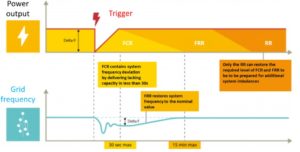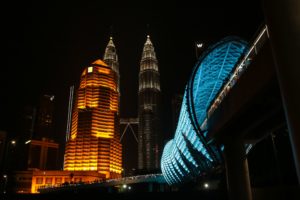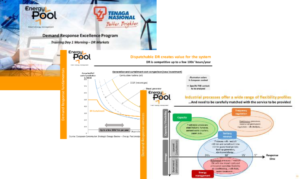Demand Response (DR) is provided by electricity consumers who accept to adjust temporarily their electricity consumption upon request against a financial compensation to contribute to ensure grid integrity in a cost-effective way.
In liberalized electricity markets, the participation of demand side resources to the wholesale and/or balancing markets are generally authorized and very often encouraged. However, with one or two exceptions, the situation is completely different in regulated electricity markets.
In this article our expert Bastien AUSSENAC takes a look at the reasons of this fundamental difference and explains how barriers to Demand Response in regulated electricity market could be removed.
Doing so, he points out the benefits of Demand Response for Utilities and its applications in regulated markets. He also describes how Energy Pool can help Utilities to identify Demand Response resources within their portfolio of customers and assess the potential of value creation from its participation to operating reserves.
1.Transmission System Operator: A key actor with key responsibilities

Electricity Transport network
Transmission System Operators (TSOs) play a key role in electricity markets. This role does not change fundamentally from a situation in which the TSO is part of the vertically integrated monopoly (regulated electricity market) or an independent company in charge of the transmission of electricity in a liberalized market (non-regulated electricity market). TSOs main responsibilities are :
– To transmit electrical power from generation plants over the electrical grid to regional or local electricity distribution operators and develop interconnections with neighbouring countries
– To ensure the balance of electricity flows on the network at any moment
As electricity cannot be easily stored, TSOs have traditionally matched demand and supply by throttling the production rate of their power plants, taking generating units on or offline, or importing power from other utilities.
There are limits to what can be achieved on the supply side, because some generating units can take a long time to come up to full power, some units may be very expensive to operate, and demand can at times be greater than the capacity of all the available power plants put together. Demand Response seeks to adjust the demand for power in a cost effective way instead of adjusting the supply.
Therefore, if it is proven that demand side resources can be reliable and competitive enough to provide services to the grid, why Demand Response would not participate more to operating reserves in regulated electricity markets?
2. Barriers to Demand Response development in regulated markets
Of course, there is no easy answer to the previous question.
Every power system has its own particularities based on factors such as generation mix, geographical layout of the power system perimeter, nature of the demand, seasonality, etc. But we can identify some quite common categories of barriers to DR implementation and development.
Barriers can be of different natures. 3 examples of the most common barriers:
– Regulatory: Lack of policies and regulations encouraging Demand Response development and/or no clear endorsement by the Government and/or the Regulator.
– Economic: Lack of incentives for Demand Response participation to the balancing system and/or impact on the current tariff structure.
– Social: Lack of trust and DR awareness for end-users to allow third party to control their process and devices. Behavioral and informational barriers are sometimes the most difficult to overcome.
A lot of these barriers can be removed, at least partially, through a detailed study conducted by independent experts of Demand Response. Thanks to this kind of study, a Utility may further explore its possibilities in the field of Demand Response, quantify the value of DR and assess the conditions under which Demand Response programs could be beneficial to both the Utility and its customers.
It is also an opportunity to draw a blueprint of a pilot program defining regulatory, financial and operational conditions under which a Demand Response program would be operated.
Last but not least, a study is a good way to involve all the stakeholders of an electricity market. Having all of them on board is important to give a political push toward this quite disruptive technology.
After coming accross these barriers, many benefits can be brought by demand response, particularly in regulated markets.
3. The benefits of Demand Response in regulated markets such as Malaysia, Taiwan or South Africa
As a vertically integrated monopoly, a Utility usually buys electricity from Independent Power Producers (IPPs) and from its own power plants to meet demand at least cost. Planning and managing generator agreements is very important to ensure supply to the electricity industry is secured, reliable and affordable.
These agreements, called Power Purchase Agreements (PPAs), define all of the commercial terms for the sale of electricity between the producer and the Utility, and generally include support’s principles for balancing under normal operations or for recovery following a grid disturbance such as an outage.
PPAs define a price that agglomerates all the services a power plant may be required to provide, such as participation to the balancing. A study is therefore necessary to assess the value of these services which, unlike in liberalized markets, are not determined by the intersection of supply and demand curves.
The cost of operating reserves varies from one reserve to another, depending on both the importance and the complexity of the service that is provided to the grid. Of course, depending on the flexibility of demand side resources, Demand Response can participate to a lot of different reserves.
However, for simplification purpose, we can consider 2 types of reserves:
– Spinning reserve (FCR and FRR): Capacity available for constant containment of frequency deviations from nominal value in order to constantly maintain the power balance in the grid and/or capacity available to restore system frequency to its nominal value after frequency deviations
– Non-spinning reserve (RR): Capacity available to restore or support the required level of frequency restoration reserve (FRR) to be prepared for additional system imbalances, including generation reserves.

Overview of FCR, FRR and RR utilization (Source : CRE)
All reserves are supplied by reserve providers (generators, storage, Demand Response) and they are used by Transmission System Operator (TSO) to maintain frequency stable within a given synchronous area.
Participating to these 2 types of reserves brings some benefits.
Economic benefits
Demand Response participation to a reserve must be economically interesting for a Utility, which is generally the case in country with developed C&I sector. Using Demand Response for non-spinning reserves for example could generate the following savings:
– Direct savings on energy cost arbitrage: using Demand Response instead of expensive peaking units on peak hours.
– Indirect savings:
– Disinvestment: existing peaking plants decommissioned earlier than expected because of Demand Response making them useless,
– Avoided investment: larger participation of Demand Response to non-spinning mechanisms instead of building a new power plant.
Social, environmental & political benefits
But in addition to the economic benefits, Demand Response development could bring a lot of other benefits for the Utility:
– Facilitates renewables integration: thanks to the flexibility of demand side resources to cope with the intermittency and the variability of renewables generation
– Ensures a reduction of CO2 emissions: competitive advantage in order to reach the environmental objectives, in particular on a decarbonated energy mix.
– Optimizes electrical flows: thanks to network congestion management
– Reduces energy imports: by modulating electrical flexibilities internally
– Increases the competitiveness of C&I: thanks to the additional revenues from balancing reserves participation
– Increases proximity and diversifies the services offered to the customers
Overall, Demand response development could not only generate savings but also strengthen the attractiveness of a market by offering social and environmental progresses and new commercial opportunities. A partner with strong experience of demand response is necessary to help a Utility to develop these flexibility mechanisms : but how ?
4. Energy Pool supports Demand Response initiatives in regulated markets
Thanks to its strong experience, managing a portfolio of 6GW of flexible industrial load and distributed generation worldwide, Energy Pool has recently conducted several studies on Demand Response and flexibility value creation assessment for major Utilities worldwide, especially in regulated markets where Demand Response is not well developed.

As described in a previous article on the Malaysian use-case, our teams work hand-in-hand with Utilities and stakeholders, from government to end-users, to conduct studies with the following objectives:
– Provide support to assess local regulation readiness for Demand Response implementation
– Define a comprehensive set of operating principles on how to structure best the Demand Response industry
– Assess Demand Response potentials and define detailed characteristics of a 1st Demand Response program
– Define the technical and functional requirements to deploy efficiently and rapidly a 1st Demand Response program.
If you represent a Utility or an actor of the electricity sector, and if this subject interests you, contact us to for more details about our solutions and services.

Exemple of training session support
Need to get this type of study ? Ask our experts here !
At Energy Pool, Bastien AUSSENAC supports Utilities in Europe, Africa and Asia, to design and deploy demand response programs and advise them on their demand response strategy. Recently Bastien advised a large Utility in South East Asia for the technical regulatory and economical design of their Demand Response industry.

